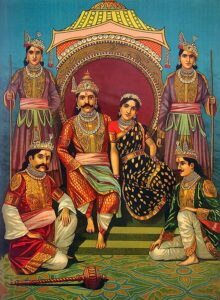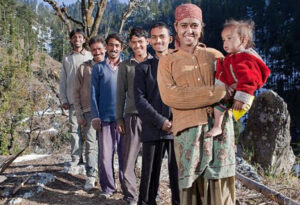Most Indians are well aware of the story of Draupadi, wife of five Pandavas, from the great epic, the Mahabharata. A princess of the Panchal king, Drupad, got married to Arjuna, the third one among the Pandavas in a swayamvar. Eventually, she became wife to all five after Kunti ordered Arjuna to distribute whatever he had brought with his brothers. Draupadi’s marriage also became one of the causes of the battle of the Mahabharata when her husband lost her to Duryodhan in the game of dice.
Nevertheless, she was not the only woman in ancient history to perform polyandry; there were many others, for instance; the story told by Vyasa of Bhaumaswi marrying five princes; Vishnu Purana mentions the story of Maharishi Kanda’s daughter marrying 10 Prachetasas, great sages; but the union of Draupadi has been regarded as the earliest evidence of polyandry.

Polyandry is a Greek word where poly means many’ and Andros means man’. It is a matrimonial arrangement where a woman is allowed to have more than one husband. This form of marriage was once prevalent in India, mainly in the Himalayan region and the south Indian region among the Todas tribe of Nilgiris of Tamil Nadu, who performed both fraternal polyandry, i.e., marrying brothers of their husbands, and also sequential polyandry, where males sharing one or two wives were not always full of half brothers.
In recent times, polyandry was declared illegal by the government after the passing of the Hindu Marriage Act 1955, but still, some areas, especially the Himalayan hilly region, have been influenced by this tradition.
Jaunsar-Bawar Valley, or tribal valley, is a remote area located in the Dehradun district of Uttarakhand in the Himalayan region. Bawar belongs to the upper snow-clad area, whereas Jaunsar falls below it, consisting of 400 villages. The area is covered with deodar and cheer trees, where people perform agriculture, animal husbandry, and beekeeping for their livelihood. The natives, Jaunsari, claim their descent from the Pandavas and follow the analogous culture of polyandry. According to their local stories, the Pandavas hid in Kinnaur, a village in Himachal Pradesh, during their 13-year exile. Another legend informs us that King Virat ruled this area of Bawar, ‘Varnavat’ as mentioned in the Mahabharata, whose daughter Uttara got married to Abhimanyu, son of Arjuna
According to the norms of marriage, the bride of the eldest son also becomes the wife of his brothers, ipso facto; however, in the presence of the elder, they cannot have any sexual relations with their common wife under one roof. The children carry the name of the eldest brother, no matter who the father is. There is an exception to having another wife if there is a huge age gap between any brother and the wife. Traditionally, a special and privileged status is given to the first among all other wives.
 The existence of this practice in this region indicates the scarcity of land, food, and basic facilities. As per the locals, this practice saves the land from getting further divided into brothers, where the elder brother works as an authority in the family. Nevertheless, this tradition has provided the jaunsaris of Bawar, specifically, a supportive medium to sustain their livelihood in the presence of limited resources, but this practice is losing its significance with the growing seeds of modernization and penetration of modern living ways in rural and remote areas. Also in the contemporary world, this tradition has been seen as an illegal practice against which the Indian government placed a total restriction in 1956.
The existence of this practice in this region indicates the scarcity of land, food, and basic facilities. As per the locals, this practice saves the land from getting further divided into brothers, where the elder brother works as an authority in the family. Nevertheless, this tradition has provided the jaunsaris of Bawar, specifically, a supportive medium to sustain their livelihood in the presence of limited resources, but this practice is losing its significance with the growing seeds of modernization and penetration of modern living ways in rural and remote areas. Also in the contemporary world, this tradition has been seen as an illegal practice against which the Indian government placed a total restriction in 1956.

